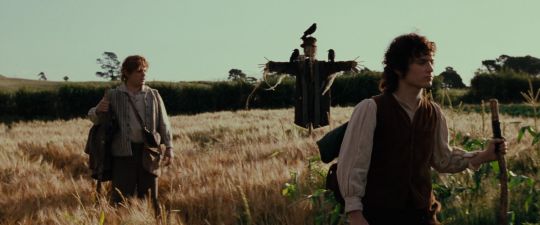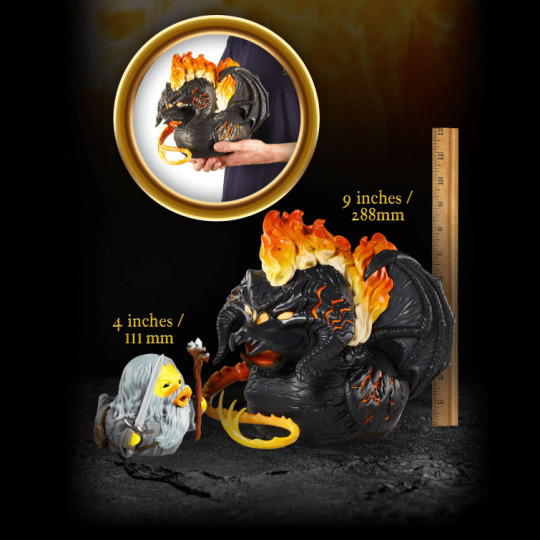#tossawary tolkien
Text
The last time that I rewatched "The Fellowship of the Ring" (extended edition, of course), my favorite new detail that I noticed is that the characters, once they set out on their journey, are pretty much always traveling from screen-left to screen-right.
It had been a few years since I'd seen the films and I'd learned more about filmmaking in that time. I'm completely biased regarding the LOTR films; they're not perfect, but I grew up on them, I love them. I was trying to take notes on all of the little details that made the world of the films seem so rich and so enchanting to me. The camerawork, character staging, and editing is one of the many things that just happened to jump out at me at this time.
When Frodo and Sam are leaving the Shire, the camera is set up in such a way that they start on the left side of the screen (<- that side) and travel across it to the right side of the screen (-> that side).

This way to go the farthest you've ever been from home. ->
As the hobbits travel from Bree to Rivendell, as the Fellowship travels from Rivendell to the Misty Mountains, all of those gorgeous scenic shots of the Nine Walkers show them moving from screen-left to screen-right. I haven't rewatched the entire trilogy lately, but in "The Fellowship of the Ring", it is so beautifully consistent.
There are a handful of reasons why this is done. In staging and editing, consistency regarding where the characters are placed on the screen is a storytelling tool. For example: the "180 degrees rule" says to generally keep the camera on one side of the characters within a scene, so that the audience can mentally keep track of the characters within the environment and focus on the action/dialogue. If we're watching two characters talking in a diner, even in the close-ups, one character will usually be kept on screen-left and be shown facing screen-right, and the other will be kept on screen-right and be shown facing screen-left. It feels stable. (People will sometimes choose to break the "180 degrees rule". It can be a tool to create a sense of disorientation and/or instability in the audience.)
In "The Fellowship of the Ring", the maps that the audience is shown of Middle Earth tell us that the Shire is located in the West (left side of the map) and everything else of relevance (Rivendell, Moria, Rohan, Gondor, Mordor) is East (right side of the map). As the characters consistently travel screen-right, the audience builds up a firmer mental map of Middle Earth and can better keep track of the characters' progress on their long journey. With every step that Frodo takes towards screen-right (->), we know that he is traveling East, taking another step towards Mordor.
Left to right may also instinctively feel like the way forward in a culture that writes and reads from left to right. Regardless of which way you write: if your film establishes extremely consistently that one direction is forward, then this visual language can be used to tell the audience that something is wrong if the characters start traveling from right to left. They might be lost! It builds suspense in the visual depiction of the characters going backwards and undoing progress! This all suits the lengthy hero's journey of LOTR very well, in my opinion.
There's an old joke that knowing how anything is made ruins the magic, and another old joke that knowing anything about filmmaking makes you insufferable to watch movies with, but I've never felt that way, especially not here. How does that quote go? It's still magic even if you know how it's done. (GNU Terry Pratchett.)
I find it enchanting, honestly, that so many people can work so hard for an effect that can seem so simple. Actors, directors, camera operators, editors, storyboarders, and so many others on the crew of the films consistently placed characters, sets, and props just so! So that the audience could more easily keep track of where everyone was and lose themselves a little more deeply in the story.
It's such a simple rule! And it works so well! Left -> Right. West -> East. Shire -> Mordor. Home -> Adventure. Known -> Unknown.
I personally recommend trying to keep track of character movement across the screen in films, especially if you have any interest in visual storytelling (films or illustration or something else). It's fun! It's impossible for me to unsee, watching "The Fellowship of the Ring" now, and I think it's a wonderful piece of movie magic.
956 notes
·
View notes
Text
Someone I know is a rubber duck enthusiast and I've been browsing for weird rubber ducks as potential gifts. Who wants to see one of the best rubber ducks I've ever seen in my life?



What bath is complete without reenacting the Gandalf versus the Balrog fight?
166 notes
·
View notes
Text
Regarding "The Hobbit" film trilogy, even if I ended up personally disliking and resenting how much time and focus the elf characters (and others) ended up taking away from the dwarves whom I think deserved more focus as rich internal characters (I know that studio pressures are a factor in that terrible love triangle and so on), I still... vaguely appreciate the effort to create and include named female characters like Tauriel, when the book is sadly lacking in them. I think she's fine, actually. Comparatively, there are many other elements in these adaptations that I think are much, MUCH worse.
But still, if you want to add female characters to this story, the obvious answer to me seems to be to just make half the Company into dwarf women? (With similarly fancy beards and other facial hair! Because I think that's fun.) It's just... so much easier?
Do NOT come at me with that "dwarf women are rare" bullshit. Unreliable narration. Logistically unlikely. Also, if you believe that "men are the warriors and craftsmen, the women stay at home" is how dwarf society strictly functions (boring, honestly, on top of being incredibly sexist), I could argue that the Battle of Azanulbizar and other struggles probably left a significant dent in this dwarf group's male population, leaving behind many widows and mothers without children to pick up the work. The battlefields have come to and TAKEN both Erebor and Moria from the dwarves. I see no good reason why dwarf women would not have equal investment in reclaiming their home and the gold. Many of the Company are not presented to be formally trained warriors, anyway.
Now, ideally, we could do way queerer stuff in terms of both romance and gender here, but we know cowards with veto powers would not let this happen. Still, I feel like basic genderbending would have been a very doable move and is, actually, a very reasonable ask of an adaptation that would have added some depth to the story even if you didn't acknowledge the change at all.
Like, preferably, this would be an adaptational change that would be directly addressed. Maybe all of the Company appear male at first due to traveling that way (and assumptions made by humans and hobbits), then Bilbo might learn that some of the Company are dwarf women when he becomes closer to all of them. We could have a brief scene acknowledging that dwarf women are fighting these battles for their pasts and their futures too. It doesn't have to be a big thing! They can just be there. Existing. Participating.
I even think it would be fun if two of the dwarves were actually an older married couple traveling together, instead of brothers or cousins, because loving married bickering and battle couples are fun. You can have running jokes in the background about how Smaug's invasion ruined their wedding day, and going back and forth with "you never take me anywhere nice" @ each other whenever they're stuck in Goblintown or the Mirkwood dungeons. (I like seeing good marriages & partnerships in fiction and established couples going on fantasy quests together. I just think it's neat.)
But another (sillier) direction is that you could just cast some actresses in beards to play some of the dwarves, then leave the fact that some of these characters are probably dwarf women (traveling as men) as a fun detail for the audience. Bilbo is either too oblivious to notice or much too polite to bring it up at all. It's canonically compliant to the text this way!
Now, obviously some few people would have complained that Tolkien's work was being ruined by "political correctness", but they complained anyway about Tauriel (when there are MANY other bad choices in these movies), and what worthwhile arguments could they have possibly made against genderbending some of the THIRTEEN dwarves? Like, most casual fans I know cannot NAME the entire Company, who get so little character development in the book that the films had to come up with unique designs and backgrounds for most of them anyway. Bro (directed towards someone objecting to the idea of including female dwarves), be real, there's no way that you honestly cared this much about "Nori the Dwarf" before right now.
185 notes
·
View notes
Note
You're my favorite SVSSS fic author, and I would love if you got into the Silmarillion/Tolkien. You're ability to do 'what-ifs' and tease out full-blown characters from scraps of information would make you a great fit
Aw, thank you. And oh, man, I am a LOTR fan, so I've been thinking about getting into book and extended Tolkien for a long time, but the time and mood has never been quite right. I just know I would get caught up in it. Maybe I'll put some Silmarillion stuff on a wishlist or look into what the library has.
I think I've given OC advice before, and there's all sorts of seminars about character goals and etc., but one of the more interesting starting points I've found useful lately for any character building stuff is to ask myself: 1) What are they angry about? 2) What are they sad about? Because everyone is angry and sad about something, and there are a whole lot of wants and needs and motivations and passion that flow in with those questions. Sometimes starting with an emotional core helps.
And I know Tolkien is just full of that kind of passion. Delicious stuff.
27 notes
·
View notes